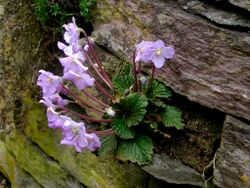Biology:Ramonda nathaliae
| Ramonda nathaliae | |
|---|---|

| |
| Scientific classification | |
| Kingdom: | Plantae |
| Clade: | Tracheophytes |
| Clade: | Angiosperms |
| Clade: | Eudicots |
| Clade: | Asterids |
| Order: | Lamiales |
| Family: | Gesneriaceae |
| Genus: | Ramonda |
| Species: | R. nathaliae
|
| Binomial name | |
| Ramonda nathaliae Pančić & Petrović
| |
| Synonyms[1] | |
| |
Ramonda nathaliae, also known as Natalie's ramonda (Serbian: Наталијина рамонда / Natalijina ramonda, Macedonian: Наталиева рамонда, romanized: Natalieva ramonda), is a species of flowering plant in the genus Ramonda that grows in Serbia, North Macedonia (mostly in the east of both[citation needed] countries) and Greece (Kilkis prefecture). The plant was scientifically described in 1884 from specimens growing around Niš, by Sava Petrović and Josif Pančić, who named it after Queen Natalija Obrenović.[2]
This is a small poikilohydryc plant[3][4][5] growing to 10 cm (3.9 in) in height. It grows from rocks at an angle, allowing rainwater to run off the surface of the leaves. It is hardy down to −15 °C (5 °F). In late spring, clusters of flat, lilac blue flowers rise from basal rosettes of rounded crenate evergreen leaves. In cultivation in the UK this plant has gained the Royal Horticultural Society’s Award of Garden Merit.[6][7]
World War I remembrance symbol
Flower is considered a symbol of Serbia's struggle and victory in World War I, with country suffering the largest casualty rate relative to its population.[8] To commemorate Serbian soldiers who died in war as well as the resurrection of the country after the devastating war, people wear artificial Natalie's ramonda as a symbol of remembrance, especially during week leading up to Armistice Day, which is a public holiday.[9]
See also
- List of Balkan endemic plants
- National symbols of Serbia
References
- ↑ The Plant List: A Working List of All Plant Species, http://www.theplantlist.org/tpl1.1/record/kew-2422130, retrieved 3 October 2015
- ↑ Blečić, Petar (11 December 2015). "Kap vode ih vraća u život" (in sr-SP). http://www.blic.rs/vesti/reportaza/kap-vode-ih-vraca-u-zivot/7evz71h.
- ↑ Drazic, Gordana; Mihailovic, Nevena; Stevanovic, Branka (1999). "Chlorophyll Metabolism in Leaves of Higher Poikilohydric Plants Ramonda serbica Panč. and Ramonda nathaliae Panč. et Petrov. during Dehydration and Rehydration". Journal of Plant Physiology 154 (3): 379–384. doi:10.1016/S0176-1617(99)80184-9. https://www.sciencedirect.com/science/article/abs/pii/S0176161799801849. Retrieved 23 August 2020.
- ↑ Babani, Fatbardha. "Ecophysiological differences between poikilohydric plants Ramonda serbica and Ramonda nathaliae. 5th International Syposium of Ecologist of Montenegro, 2013". https://www.academia.edu/20993117.
- ↑ Rakić, Tamara; Lazarević, Maja; Jovanović, Živko S.; Radović, Svetlana; Siljak-Yakovlev, Sonja; Stevanović, Branka; Stevanović, Vladimir (2014). "Resurrection plants of the genus Ramonda: prospective survival strategies – unlock further capacity of adaptation, or embark on the path of evolution?". Frontiers in Plant Science 4: 550. doi:10.3389/fpls.2013.00550. PMID 24454318.
- ↑ "RHS Plantfinder - Ramonda nathalie". https://www.rhs.org.uk/Plants/14327/i-Ramonda-nathaliae-i/Details.
- ↑ "AGM Plants - Ornamental". Royal Horticultural Society. July 2017. p. 84. https://www.rhs.org.uk/plants/pdfs/agm-lists/agm-ornamentals.pdf.
- ↑ President honors Serbian WW1 soldiers in Greece: In commemoration of Armistice Day, President Tomislav Nikolić paid homage to fallen Serbian soldiers at the Greek island of Vido., http://www.b92.net/eng/news/politics.php?yyyy=2012&mm=11&dd=11&nav_id=83109
- ↑ "Serbia to mark Armistice Day as state holiday". 9 November 2012. https://www.b92.net/eng/news/society.php?yyyy=2012&mm=11&dd=09&nav_id=83083.
External links
| Wikimedia Commons has media related to Ramonda nathaliae. |
Wikidata ☰ Q1966416 entry
 |

